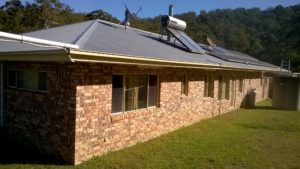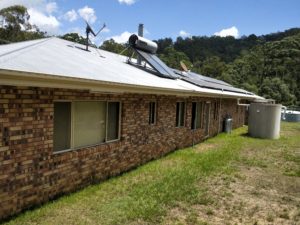Well, … who would have thought that being thermally comfortable in a habitable construction would qualify as “fit for the purpose” criteria for a family home? Is thermal comfort really that important? I would suggest that if you exist in a dwelling that is so cold at night in the winter that it is difficult to fall asleep or so hot in the summer months that a restful sleep cannot be achieved, then one of the fundamental “fit for the purpose” criteria is not being met. Heaters or air conditioners can limit to make conditions more comfortable or at least bearable, but wouldn’t it be better if the building was built in a way that the running of climate control equipment was unnecessary or at least reduced to a point where that expense occurred on only rare occasions?
From a practical perspective, a family of five or six people being crammed into a one bedroom dwelling obviously falls short of being “fit for the purpose”. Of course, a house can be built with more bedrooms to suit the family’s size and houses can also be designed and built to suit a location’s climatic conditions. Whilst there may be a place for one-bedroom apartments or multi-bedroom houses, there is no need to have a dwelling so poorly designed and built that it thermally under-performs to the point where it affects the comfort or even the health of the inhabitants. I suggest that a dwelling such as this should be considered not “fit for the purpose”. https://johnlynn.lpages.co/home-energy-secrets-book-1/
 (Pic 1 Winter Solstice. Maximum exposure to sun.)
(Pic 1 Winter Solstice. Maximum exposure to sun.)
The standards have been set in various countries around the world to address this concern. Included in part of Australia’s efforts to lift the thermal performance of all prospective new homes and major renovations, each application for construction needs to have a computer program assess a number of aspects that will determine how it will thermally perform over any typical season. I have said on many occasions that a home’s thermal comfort is determined long before the house is ever built. There are three “approved” programs for Australian and they have been calibrated to deliver a star-rating out of ten. The higher the number the more thermally stable a building will be. No application will be approved for any construction or major renovation on a home that does not meet or exceed a six star-rating. Multistory constructions must meet the minimum standard of five-stars. The devil is always in the detail but suffice to mention here is that multistory constructions have issues that traditional Australian family home’s do not. In fact, is not that difficult to achieve or even exceed the minimum building expectations and I suggest that anyone considering building considers the cost to benefit of constructing a home with the highest possible star-rating possible. Energy Efficient/Thermally Stable Homes are worth increasingly more in the marketplace, rent for more and when marketed correctly they sell more readily than lower performing dwellings. People like to be comfortable and are willing to pay a little extra to have a more “fit for purpose” home. From my childhood I have always appreciated the saying that “quality is remembered long after price is forgotten”.
When shopping for a new abode to either rent or buy, have a long-term plan that includes you being happy to go home to thermal comfort on as many days of the year as can be achieved.
The factors that need to be considered when making an informed choice whilst considering a change in one’s lodgings include, the dwellings Climate Zone, ie location, construction materials both inside and out, it’s orientation relative to the equator (which will be affected by it’s design/shape and room zoning), window size, window location, window type and insulation. This list is most certainly not exhaustive, but it includes the basics and fundamentals. The Climate Zone needs to be considered as building a thermally “fit for purpose” home in an alpine region will include many differences from a “fit for purpose” home in the Simpson Desert. Those differences will include the types of building materials used in construction including materials with high thermal mass and building materials with low thermal mass, and, most importantly where those materials are used. (NB materials with high thermal mass store heat, eg. bricks. Materials with low thermal mass do not store heat eg. wood paneling. The shape and design of a building and its relationship with the equator will determine sun exposure over the seasons. The latitude will determine sun height from season to season and the design and placement of the dwelling will dictate where heat is gained and held. The window type, size and placement will affect sun access inside the home. Putting a large single pane glass window on the western wall in a desert is “thermal suicide” but may be considered advantageous in a high mountain region where cold weather is predominate.  Then there’s the type, rating and location of a dwelling’s insulation which becomes more and more fundamental in climate zones where weather and temperature extremes are experienced. Living coast side has the advantage of the Maritime Effect where the huge heat sink of the ocean stabilizes and therefore reduces the probability of extreme temperature fluctuations. Mother nature is passively keeping the temperature variations low as she conforms with the law of entropy, being the 2nd law of thermodynamics. Most people live along the coastal regions of countries and for good reason.
Then there’s the type, rating and location of a dwelling’s insulation which becomes more and more fundamental in climate zones where weather and temperature extremes are experienced. Living coast side has the advantage of the Maritime Effect where the huge heat sink of the ocean stabilizes and therefore reduces the probability of extreme temperature fluctuations. Mother nature is passively keeping the temperature variations low as she conforms with the law of entropy, being the 2nd law of thermodynamics. Most people live along the coastal regions of countries and for good reason.
https://johnlynn.lpages.co/home-energy-secrets-book-1/
(Pic 2 Summer Solstice. Minimum exposure to sun.)
Living in a dwelling on an open plain in the middle of any continent and therefore being far from the sea will not enjoy the more stabilized temperatures of the coast. Then there is the ground temperature at the building’s location to be considered.
If earth temperature at location is uncomfortably cold, ie 8 0C then the dwelling will need to be insulated so that the earth is not “stealing” any auxiliary warmth generated to make the home more comfortable. Conversely if the ground temperature is too hot ie 28 0C then living areas need to be insulated and separated from the ground to stop natural laws from transferring heat from the ground into the home. If, however the ground temperature at your location is near to or in what I call “the sweet spot”, then let’s use the laws of nature to warm and cool your home on every day of the year. That’s what I do. It has been working well for those who use this to their advantage and has done so since when dinosaurs walked around growling or whatever they did back in those days.
There are a lot of factors to consider but for those in the know it’s just another day at the office. Making changes on a building plan for convenience or lifestyle, ie relocating the lounge room to the northern side or changing the size, shape or location of a window will impact on the thermal performance of your home. Changing the tense of a word in a sentence means other changes in wording are necessary for the sentence to be clear and understandable, ie “fit for the purpose” of clear communication. Everything plays together like an orchestra and must be shaped and placed to get the best outcome. One small change on plan may well significantly impact the thermal performance of your home. Remember to get it right the first time because you don’t get a second chance to get it right the first time. Where possible, strive to live in a house with the highest star-rating you can because a thermally comfortable house is more likely to be a “fit for the purpose” home.
Get your FREE copy of “Savvy Up and Save” here >>>LEARN MORE>>>
Moreton Bay residents can access weekly tips from John on Community Radio 101.5 FM Friday Mornings at 10:10am
John Lynn
